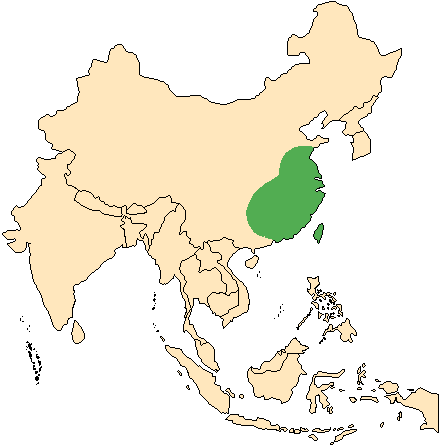![]() Return
to Artiodactyla
Return
to Artiodactyla
Classification
|
 Muntiacus
reevesi
Muntiacus
reevesi
Reeves's muntjac
![]()
Taxonomy
 |
 |
 |
Click on the pictures above for a larger view of the
photographs
|
||
General Characteristics
Body Length: 90 cm / 3 ft.
Shoulder Height: 40 cm / 16 in.
Tail Length: 10 cm / 4 in.
Weight: 11-16 kg / 24-35 lb.The short, soft coat is a reddish brown in colour, with the undersides, including the lower legs and the ventral surface of the neck and chin, fading to creamy white. The forehead and nose are black, while the surrounding face is generally a pale tan. Males have small tusk-like canines, which can grow up to 2.5 cm / 1 inch long and small antlers, averaging 7-8 cm / 2.75-3.2 inches in length. These are mounted on skin-covered pedestals which slope back from the face. Females also have remnant pedicels which are seen as small bony knobs on the forehead. The body is rounded, and the legs are slender, the overall form resembling that of the South American agouti.
Ontogeny and Reproduction
Gestation Period: 7 months.
Young per Birth: 1, sometimes 2.
Weaning: At 2 months.
Sexual Maturity: At 6-12 months.
Life span: Up to 17 years.Breeding occurs primarily from January to March
Ecology and Behavior
Captive observations indicate that the Reeves's muntjac is primarily crepuscular, active at dawn and dusk, although both diurnal and nocturnal activity have been reported. When alarmed or in the presence of potential danger, muntjacs make a sharp barking sound, which is surprisingly loud and gives them their alternate name "barking deer". There are a number of possible explanations for this behaviour, although the true reason is not known. This noise may serve as a warning to the predator that it has been spotted, and hence that its chances of a successful hunt have been reduced. The vocalizations may also serve as communication between individuals. In either case, there is a correlation between intensive barking an reduced visibility. Both sexes defend small, solitary territories, chasing away most conspecifics who are viewed as resource competitors. These territories are marked with preorbital gland secretions. Although the antlers of males may be used in battle, the sharp canines are the more dangerous weapon.Family group: Solitary or in small groups.
Diet: Grasses, sprouts, fruits, seeds, carrion, eggs.
Main Predators: Leopard, tiger, dhole, jackal, crocodile, python.
Distribution
Deciduous forests in southern China and Taiwan.

Range Map (Redrawn from Whitehead, 1993)
Conservation Status
Reeves's muntjac is a common species.
Remarks
An adaptable animal, this small deer has escaped from British gameparks and now lives ferally in the southern portion of Great Britain.
Muntiacus (New Latin) from muntjak, the native name for these deer in the Sunda language, in western Java. Named after John Reeves, FRS (1774-1856), a British naturalist who was resident in China from 1812 to 1831. He studied the natural history of the country, and sent specimens back to England.
Literature Cited
Kurt, F. 1990. Muntjac deer. In Grzimek's Encyclopedia of Mammals. Edited by S. P. Parker. New York: McGraw-Hill. pp. 137-139.Nowak, R. M. [editor]. 1991. Walker's Mammals of the World (Fifth Edition). Baltimore: The Johns Hopkins University Press.
Whitehead, K. G. 1993. The Whitehead Encyclopedia of Deer. Stillwater, MN: Voyageur Press, Inc.
Wilson, D. E., and D. M. Reeder [editors]. 1993. Mammal Species of the World (Second Edition). Washington: Smithsonian Institution Press. Available online at http://nmnhwww.si.edu/msw/
Return to Artiodactyla

![]()
© Brent Huffman, www.ultimateungulate.com |
|
|